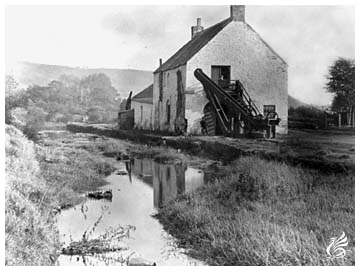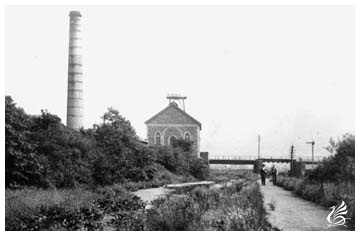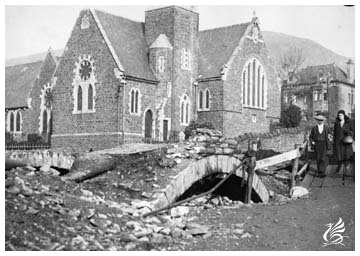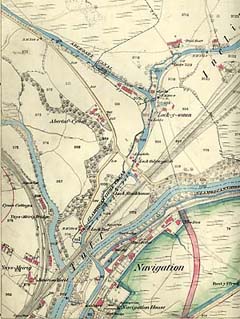
| Aberdare Canal | |
The Aberdare Canal Act of 1793 authorised a canal to be constructed from Aberdare to Navigation (Abercynon), where it would join the Glamorganshire Canal, which ran from Merthyr Tydfil to Cardiff. The Act also gave authority for the construction of a tramroad to the terminus of the Neath Canal near Glyn Neath. |
|
By 1806 another two Ironworks had opened at Llwydcoed and Abernant, so the Aberdare Canal Company felt the time was right to exploit the potential growth of industry in the area by building a canal. The canal was surveyed in 1810 and was open in May 1812. The terminus of the canal was at Canal Head, Ty Draw, where four wharves, each 80 feet long were constructed. When constructed the Canal was just under 7 miles long and was spanned by 18 bridges. The Canal only fell by 13 feet over its entire course so just two locks were needed: The Cwmbach or Upper Lock which was near the site of the present day Duffryn Arms; and the Duffryn Lock which was just North of Mountain Ash. Water supply was by a feeder from the River Cynon that joined the Canal at Canal Head. Wharf at Canal Head. Just a few years after its closure in 1900 the Aberdare Canal was already choked by weeds |
 |
| It would have taken a boat 3 to 4 hours to make the journey from canal Head to the junction with the Glamorganshire Canal at Abercynon. A round trip from Aberdare to Cardiff and back could theoretically be done in 30 hours, but as many of the boatmen would have stayed overnight at Nantgarw, two round trips a week was the norm. Unfortunately, the Canal opened just as there was a slump in the iron trade. All three of the Ironworks ceased production and by July 1814 the Canal was no longer economically viable. The Canal was not used between 1815 and 1818 and its fortunes only revived when the iron trade picked up again in 1819. After William Crawshay II bought Hirwaun ironworks in 1819 he sought to control the transport network to the works, by 1826 he had succeeded in purchasing 96 shares in the Aberdare Canal Company and was the senior figure in the Company. In the 1820's and 1830's the iron trade was the source of steady business on the canal and the company returned modest dividends to its shareholders. |
|
 |
However, in the late 1830's a new source of business began to emerge in the Aberdare Valley, which would have a profound impact on not only the Aberdare Canal, but also the whole of South Wales. In 1837 Matthew Wayne and his son Thomas Wayne opened the Abernant-y-Groes Colliery in Cwmbach. The first colliery opened to exploit the export potential of Aberdare coal. Within a few years a number of collieries had opened up on the banks of the Canal or in close proximity to it, including Middle Duffryn (1843), Upper Duffryn (1840) and Blaengwawr (1843). The next thirty years were a period of general prosperity for the Canal as it could rely not only on its staple business from the Ironworks, but also shared in the business created by the burgeoning coal industry. Left: Middle Duffryn Colliery and the Aberdare Canal, circa 1910
|
| The Canal therefore enjoyed a boom period during the 1840's and 1850's, despite the penetration of the railways in to the valley. The Taff Vale Railway opened in 1846 and the Vale of Neath Railway in 1851. Ultimately, however, the Canal could not survive in the face of the competition from the railways. When the iron industry collapsed in 1875 the canal lost its core business, as by then the collieries were using the railways to transport their goods. The canal continued to transport agricultural and building materials but this trade was small and the Canal barely covered operating costs. From the late 1870's the Canal also began to suffer from subsidence caused by coal mining. | |
In 1884 the Marquis of Bute bought both the Aberdare and Glamorganshire Canals. Despite substantial investment the Canals did not return a profit and subsidence began to get worse. Maintenance costs rose and in 1900 the Aberdare canal was forced to close on the grounds of public safety. Demolition of the Ffrwd Canal Bridge, Mountain Ash,during the process of filling in the canal and constructing the new road, circa 1924. |
 |
